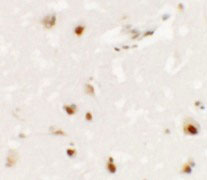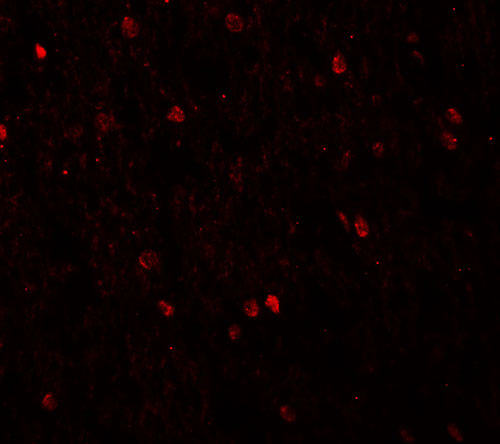SHANK3 Antibody
- 产品详情
- 实验流程
- 背景知识
Application
| WB, IF, E, IHC-P |
|---|---|
| Primary Accession | Q9BYB0 |
| Other Accession | NP_001073889, 122937241 |
| Reactivity | Human, Mouse |
| Host | Rabbit |
| Clonality | Polyclonal |
| Isotype | IgG |
| Calculated MW | 191338 Da |
| Concentration (mg/ml) | 1 mg/mL |
| Conjugate | Unconjugated |
| Application Notes | SHANK3 antibody can be used for detection of SHANK3 by Western blot at 1 µg/mL. Antibody can also be used for immunohistochemistry starting at 2.5 µg/mL. For immunofluorescence start at 2.5 µg/mL. |
| Gene ID | 85358 |
|---|---|
| Other Names | SH3 and multiple ankyrin repeat domains protein 3, Shank3, Proline-rich synapse-associated protein 2, ProSAP2, SHANK3, KIAA1650, PROSAP2, PSAP2 |
| Target/Specificity | SHANK3; At least three alternatively spliced transcript isoforms of SHANK3 are known to exist. |
| Reconstitution & Storage | SHANK3 antibody can be stored at 4℃ for three months and -20℃, stable for up to one year. As with all antibodies care should be taken to avoid repeated freeze thaw cycles. Antibodies should not be exposed to prolonged high temperatures. |
| Precautions | SHANK3 Antibody is for research use only and not for use in diagnostic or therapeutic procedures. |
| Name | SHANK3 |
|---|---|
| Synonyms | KIAA1650, PROSAP2, PSAP2 |
| Function | Major scaffold postsynaptic density protein which interacts with multiple proteins and complexes to orchestrate the dendritic spine and synapse formation, maturation and maintenance. Interconnects receptors of the postsynaptic membrane including NMDA-type and metabotropic glutamate receptors via complexes with GKAP/PSD-95 and HOMER, respectively, and the actin-based cytoskeleton. Plays a role in the structural and functional organization of the dendritic spine and synaptic junction through the interaction with Arp2/3 and WAVE1 complex as well as the promotion of the F-actin clusters. By way of this control of actin dynamics, participates in the regulation of developing neurons growth cone motility and the NMDA receptor-signaling. Also modulates GRIA1 exocytosis and GRM5/MGLUR5 expression and signaling to control the AMPA and metabotropic glutamate receptor-mediated synaptic transmission and plasticity. May be required at an early stage of synapse formation and be inhibited by IGF1 to promote synapse maturation. |
| Cellular Location | Cytoplasm. Postsynaptic density. Cell projection, dendritic spine. Note=In neuronal cells, extends into the region subjacent to the postsynaptic density (PSD). |
| Tissue Location | Expressed in the cerebral cortex and the cerebellum |
For Research Use Only. Not For Use In Diagnostic Procedures.
Provided below are standard protocols that you may find useful for product applications.
BACKGROUND
SHANK3 Antibody: SH3 and multiple ankyrin repeat domains 3 (SHANK3), a member of the Shank gene family, plays a role in synapse formation and dendritic spine maturation. Shank proteins (Shank 1-3) containing PDZ domains are scaffold proteins of the postsynaptic density (PSD) that connect neurotransmitter receptors and ion channels proteins to the actin cytoskeleton and G-protein-coupled signaling pathways. Transcript splice variation in the Shank family influences the spectrum of Shank-interacting proteins in the PSDs of adult and developing brain to ensure normal development. Mutations of SHANK3 are a cause of autism spectrum disorder (ASD) and the neurological symptoms of 22q13.3 deletion syndrome.
REFERENCES
Sheng M and Kim E. The Shank family of scaffold proteins. J. Cell Sci. 2000; 113:1851-6.
Park E, Na M, Choi J. The Shank family of postsynaptic density proteins interacts with and promotes synaptic accumulation of the PIX guanine nucleotide exchange factor for Rac1 and Cdc42. J. Biol. Chem. 2004; 278:19220-9
Lim S, Naisbitt S, Yoon J, et al. Characterization of the Shank family of synaptic proteins. Multiple genes, alternative splicing and differential expression in brain and development. J. Biol. Chem. 1999; 274:29510-8.
Durand CM, Betancur C, Boeckers TM, et al. Mutations in the gene encoding the synaptic scaffolding protein SHANK3 are associated with autism spectrum disorders. Nat. Genet. 2007; 39: 25-7.
终于等到您。ABCEPTA(百远生物)抗体产品。
点击下方“我要评价 ”按钮提交您的反馈信息,您的反馈和评价是我们最宝贵的财富之一,
我们将在1-3个工作日内处理您的反馈信息。
如有疑问,联系:0512-88856768 tech-china@abcepta.com.























 癌症的基本特征包括细胞增殖、血管生成、迁移、凋亡逃避机制和细胞永生等。找到癌症发生过程中这些通路的关键标记物和对应的抗体用于检测至关重要。
癌症的基本特征包括细胞增殖、血管生成、迁移、凋亡逃避机制和细胞永生等。找到癌症发生过程中这些通路的关键标记物和对应的抗体用于检测至关重要。 为您推荐一个泛素化位点预测神器——泛素化分析工具,可以为您的蛋白的泛素化位点作出预测和评分。
为您推荐一个泛素化位点预测神器——泛素化分析工具,可以为您的蛋白的泛素化位点作出预测和评分。 细胞自噬受体图形绘图工具为你的蛋白的细胞受体结合位点作出预测和评分,识别结合到自噬通路中的蛋白是非常重要的,便于让我们理解自噬在正常生理、病理过程中的作用,如发育、细胞分化、神经退化性疾病、压力条件下、感染和癌症。
细胞自噬受体图形绘图工具为你的蛋白的细胞受体结合位点作出预测和评分,识别结合到自噬通路中的蛋白是非常重要的,便于让我们理解自噬在正常生理、病理过程中的作用,如发育、细胞分化、神经退化性疾病、压力条件下、感染和癌症。








